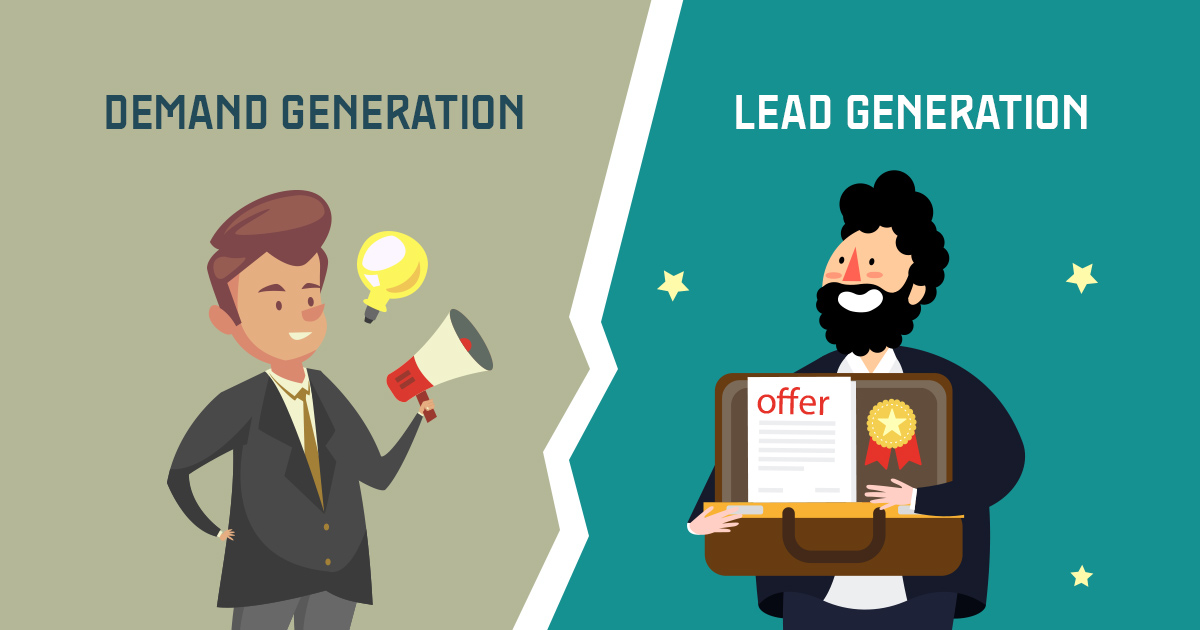Lead or Demand Generation – Which Drives Your Business Success?

If you want to develop your business, you must understand lead generation and demand generation. These two marketing strategies may seem similar, but they focus on different goals. Knowing the difference can help you get better results.
Research shows that 61% of marketers say lead generation is their biggest challenge, while 70% focus on building brand awareness with demand generation. Companies that combine both strategies can grow their revenue by over 200% compared to those that don’t.
To understand better demand generation and lead generation, you need to know how they differ and how you can use both to grow your business.
How Demand Generation Works?
Demand generation is all about getting people interested in what your business offers. Instead of jumping straight into selling, the goal is to build awareness and show potential customers why they need your product or service. It emphasizes educating your target audience, delivering useful content, and telling your brand’s narrative. Over time, this positions your brand as a trusted solution to their problems.
Think of demand generation like planting seeds. You’re preparing the ground and creating the right conditions for growth—not expecting immediate results.
A strong demand generation strategy has a few key parts:
- Buyer persona development involves knowing your ideal customers. Create profiles based on their demographics, job roles, industry, and needs. Understanding their pain points and where they are in the buying journey is essential.
- A multi-channel approach helps you reach your audience on the platforms they use most, such as social media, email, or blogs. Use data to identify which channels work best for engaging them.
- Content quality and relevance are crucial for building trust. Provide valuable content that addresses your audience’s problems and positions your brand as an expert.
- Building trust means becoming a reliable resource. When your audience is ready to make a decision, they’ll turn to you for solutions.
How to Do Lead Generation?
Lead generation is a more direct approach to turning interest into high-quality leads. The goal is to obtain contact information from prospective clients who are already interested in your product or service. This helps your sales team reach out and guides them toward becoming paying customers.
Lead generation is like harvesting crops. After building awareness, you’re now collecting the fruits of your efforts by capturing leads and moving them through the sales funnel.
A successful lead generation strategy includes:
- Targeted campaigns focus on creating campaigns that directly address your ideal customers and their specific needs.
- Free trials, e-books, or webinars are examples of compelling offers that provide something worthwhile in exchange for contact information.
- Clear calls-to-action (CTAs) make it easy for visitors to sign up, download resources, or request more information.
- Landing pages are dedicated pages with clear information and simple forms designed to capture leads effectively.
Demand Gen vs. Lead Gen: The Differences
The difference between lead generation and demand generation lies in their focus and approach. Knowing how they work together can help you develop a comprehensive marketing strategy that attracts and converts your target audience.
Goal
Demand generation focuses on building awareness and interest in your brand, while lead generation aims to capture contact information and convert that interest into actionable leads.
Focus
Demand gen is about educating and engaging potential customers, whereas lead gen focuses on gathering contact details from those already interested.
Approach
Demand generation takes a long-term, nurturing approach, while lead generation is more short-term and transactional.
Content
Demand gen content is informative, valuable, and aimed at building your brand. Lead gen content is offer-driven and focused on capturing leads.
Measurement
The success of demand generation is assessed by brand awareness, internet traffic, and social engagement. Lead generation is measured by the number of leads and the conversion rates.
Position in the Sales Funnel
Demand gen targets the top of the funnel to attract new prospects. Lead gen works in the middle to bottom of the funnel to convert prospects into leads.
How Lead and Demand Generation Works Together
Both demand generation and lead generation are key parts of a successful marketing strategy. They collaborate to guide potential clients through the buying process. For the best outcomes, demand generation and lead generation should be combined.
Demand generation starts with creating valuable content that educates and raises awareness about your product or service without asking for anything in return. Once people are familiar with your brand, lead generation comes into play. At this stage, you offer more in-depth content, such as a guide or webinar, in exchange for their contact information.
By combining both strategies, you can attract a broader audience while capturing high-quality leads genuinely interested in what you offer.
How to Measure Success
Measuring success is critical to determining whether your marketing activities are effective. Tracking the proper metrics enables you to develop your strategy and achieve your business goals.
Demand Generation Metrics:
- Website traffic growth
- Social media engagement
- Content shares
- Increased brand mentions
- Number of leads captured
- Conversion rate (leads to customers)
- Cost per lead (CPL)
- Email campaign performance
The Power of a Balanced Marketing Approach
Demand generation creates a foundation by educating and engaging potential customers, while lead generation capitalizes on that foundation to drive conversions. When you view them as a continuous cycle rather than separate efforts, you stop chasing short-term wins and start building a long-term growth engine. The real power lies in how these strategies feed into each other, turning awareness into action and interest into lasting customer relationships.
